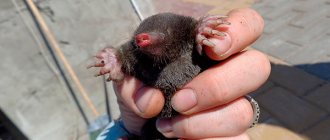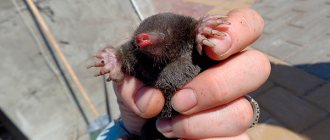The mole is a carnivore. Its main food is earthworms, which are so necessary and useful for the fertility of garden beds. True, in addition to this, the mole will be able to free the garden from mole crickets, fly larvae, May beetles and click beetles, from slugs and cutworm caterpillars, mice and even rats. The small mammal is not at all interested in root vegetables or tomato bushes. However, when hunting for its prey, it digs so many underground tunnels that whole pieces of beds with onions or carrots can fall into them. Heaps of earth dug up by the animal regularly appear in the most unexpected place for a gardener. And a recently planted young tree, whose roots are undermined, begins to dry out, leading the gardener to despair. So, how to get rid of moles on your property: the most effective way.
What harm and benefit can be caused to a summer cottage
Moles and shrews are active animals. Their benefits in the garden are enormous, because they:
- loosen the soil, making deep passages;
- get rid of the invasion of mole crickets, wireworms, and cockchafers by eating them.
The harm is that the animals form voids in the ground, digging labyrinths of wide passages and damaging the roots of plants, fruit plants, and trees. They lose contact with the ground and dry out.
Animals dig everywhere, be it a garden bed or a flower bed. Shrews do the most damage, causing damage to root crops and vegetable crops.
Attention! Animals in the country are overly active. They constantly build labyrinths underground, damaging the root system of trees and cultivated plantings.
Is it worth catching moles with fish hooks?
There is another cruel way to catch a mole - catching it with a fishing hook. The principle is simple: a small hole is made in the arch of the passage, into which a fishing line with several fishing hooks is lowered (usually tees are used to be sure), the end of this fishing line is tied next to a metal pin driven into the ground or simply to a strong stick lying on the ground.
The mole, going along its course, runs into a fishing hook and it digs into the body, piercing the skin. The animal cannot free itself and tugs on the fishing line, which is visible on the surface (sometimes a bell is tied to the pin, which at that moment begins to ring). After this, the gardener can only dig out the passage with a garden shovel and pull the struggling mole to the surface directly by the fishing line.
During such manipulations, the mole's side or abdomen is sometimes literally torn apart with a hook. And it is quite obvious that the knackers who use such a means of capture will definitely not stand on ceremony with the animal after it is caught.
There is an even more sophisticated way of mocking a mole - using the same fishing hooks with earthworms pre-attached to them. The animal will try to eat such bait, and the hook will stick into its mouth or throat.
On a note
Perhaps somewhere here lies the line when cruelty to animals begins to border on sadism: if a simple gardener at the dacha is able to catch moles in such ways, then why are we surprised when somewhere in a foreign country a live seal’s nose is sawed off with a grinder or They skin foxes alive on fur farms.
Let us only add here that in terms of efficiency and labor intensity, catching a mole with a hook is comparable to using live traps. But if adequate gardeners try to save the life of the animal and not injure it, then sadists, of course, will be more interested in figuring out how to catch a mole with fishing hooks.
Application of gas tablets
Gas tablets are gentle and highly effective. Animals that cannot stand the smell of gas do not die, but manage to run away . If you throw them into holes and sprinkle them with earth, the effect of the tablets occurs after 3-4 days. Range: 4.5–5m. Of course, one-time use is unlikely to be effective. The gas in the ground becomes neutral after 2–3 days. If you carry out several treatments, the moles and shrews will leave the area, because... do not tolerate volatile substances with a pungent odor.
Advice! To treat the area, it is recommended to use a pack of tablets (25–30 pieces) in 2–3 doses. The main thing is to wear protective rubber gloves when working, follow safety precautions, and do not forget that gas tablets are a chemically active reagent.
Catching moles with a shovel
This method of catching moles is as simple in principle as it is complex in implementation: a gardener with a bayonet shovel waits near the mole’s passages when the animal passes through one of the galleries close to the surface of the earth. At this moment, the ground above him rises slightly, and the movement of the animal is clearly visible. The catcher’s task is to stick the bayonet of the shovel behind the mole and quickly throw the soil with the animal itself to the surface of the earth.
It is also useful to read: What are moles afraid of: methods of scaring them off with carbide, smoke and other means
The main difficulties of this method:
- Usually you have to spend a lot of time before you can notice the movement of the mole along its course. As a rule, moles inspect tunnels once every few hours, but they may not visit individual branches for days at a time. So there is no guarantee that a person on duty in a certain part of the garden will wait for the animal to appear;
- In addition, the mole needs to be dug up very quickly - the animal moves underground quite quickly, and can avoid the fate of being caught if the gardener is slow.
Nevertheless, the experience of a considerable number of gardeners shows that this method is generally quite effective and widespread: many people catch moles with a shovel.
Review of popular brands
Manufacturers offer various remedies for moles and shrews on the site: tablets, poisonous baits, ultrasonic repellers. The most popular of them are:
"Dakfosal"
The fumigation insecticide begins to emit heavy gas upon contact with the soil, spreading throughout all passages, penetrating into hard-to-reach places. Two to three tablets are placed at maximum depth. The hole is filled with earth.
DETIA
DETIA with essential oils, safe for people and soil, but effective against moles. The balls are buried at a distance from each other in the hole. Poisonous toxins immediately begin to evaporate. To achieve results, the procedure must be repeated at least 2 times per season.
"Russian Trap"
Bait in the form of paraffin briquettes is used to expel shrews, moles, rats, and mice from a summer cottage. Contains: active brodifacoum and fragrances with a suffocating effect.
ARGUS (gel)
One tube (30 g) is sufficient to distribute at the entrance to each burrow. The active substance is brodifacoum. Causes paralysis.
"Alphos Krot"
An effective drug against moles, hamsters, and gophers. It releases alphos (heavy gas), which gradually displaces air, settling to a soil depth of 3–4 m. The drug will not leave behind new mole spots after 7–10 days. Animals will become afraid and leave the area. For use:
- scatter around the area, throw into holes;
- sprinkle with earth.
The result can be observed within 20 hours after use.
The tablets are used according to the instructions. Do not open the packaging indoors.
"Stop the Mole"
A toxic chemical with migratory properties that quickly fills burrows. 2-3 tablets are placed in each hole and covered with earth. It is better to carry out procedures during the day (from 12:00 to 16:00). Predators immediately leave the dug up areas.
Reference! It is not recommended to throw tablets into holes after rain, or to inhale the gas released.
"Green House Antikrot"
Poisonous gel concentrate is a poison against shrews and moles in a summer cottage. Contains active bromadiolone. One treatment with placing 15 grams into a mole hole is enough, and the desired result will not take long to arrive.
"Antrokot" is a good remedy with a long-lasting effect and is affordable. Eliminates entire populations of rats, mice, moles. Although, according to the instructions, you have to breed the bait yourself.
How to use poison baits
Baits (granules, pastes, tablets, briquettes) are effective poisons for moles and shrews in a summer cottage. Poisonous baits (“Russian trap”, “Antikrot”) are used when other methods become useless. When poison enters the stomach of rodents, it causes muscle paralysis, failure of the nervous system, suffocation, internal bleeding, and death. The substance decomposes slowly (within 1 month).
If the bait is thrown into a hole or buried throughout the area, then mass death of rodents will be observed within a week.
To use the remedy against moles and shrews in a summer cottage:
- throws several doses at once into fresh holes;
- buried in the ground throughout the entire area;
- checked after 2 days;
- more poison is added if necessary.
It is better to poison rodents in dry, windless weather.
Using used cat litter to fight moles from Evgeniy Klyuev
In war, all means are good. Evgeniy Klyuev, for example, uses used cat litter (a good owner, as you know, never wastes anything, even used cat litter).
In a bucket of water, mix a lump of litter with cat waste. Fill the mole holes with the resulting solution, and then cover them with earth. Take a piece of reinforcement and use it to make many holes in the ground near the molehills. The animals will then move to a safe distance and stay away from your area.
Application of the barrier method
Metal or plastic mesh of different sizes is used. For what:
- a trench is dug 80 cm deep and 30 cm wide;
- The mesh is laid and sprinkled with earth.
The goal of the method is to make a fence 25 cm high above the ground. Ideally, use a plastic material that will not rot or lose strength for up to 25 years.
To control pests on lawns, it is better to lay a net over the area to a depth of 20 cm, sprinkling soil on top. Judging by the reviews, a barrier mole trap is one of the best options. After all, you can lay a net on your site and forget about rodents for a long time.
Natural enemies
Moles and shrews belong to the order of insectivores, but they are often associated with rodents. Cats and dogs are not averse to hunting small animals, with the only difference being that they do not eat moles and shrews. Animals have special scent glands that begin to intensively produce aroma in case of danger. This smell kills all appetite. However, this does not prevent cats and dogs from catching animals or scaring them away with their appearance.
In most cases, cats and dogs help remove moles and shrews voluntarily. Animals themselves find mole holes and wait for the animals. A person can only not interfere with this process.
Review
Moles appear on my property from time to time, but they don’t cause me much harm. The cat can handle them without any problems. He carries the animals to me like a trophy. After some time, all the remaining animals flee the area.
Irina, Moscow
Is it possible to use sulfur bombs and firecrackers?
Smoke and sulfur bombs:
- light up;
- placed in passages, holes in the ground;
- tightly covered with a sheet of plywood or a bucket.
As the smoke spreads along the passages, it begins to have a poisonous effect, scaring away shrews and moles from the summer cottage.
If firecrackers are used, they are placed in the passages, covered with a bucket, then exploded in a wave. The roar quickly spreads through the underground passages, deafens and scares away the animals. Another option for using firecrackers:
- place on a small container treated with ammonia;
- Set it on fire so that a fine ammonia smell begins to spread.
Important! Repellent smoke bombs are not the most humane method of repelling. They poison the soil and lead to the death of worms and insects.
Lethal means
Products that kill moles upon capture are available in various variations, and they implement different principles of action.
Let us note the most popular of them:
- A plunger trap is installed above the mole's passage, and a guard is lowered into the passage itself. As the animal passes along the way, the guard descends and the brackets on a powerful spring crush the mole’s body. After this, the animal suffers from several seconds to several hours, after which it dies;
- A harpoon trap (it is also sometimes referred to as a plunger trap due to its design features) is installed above the passage, and when lowered, the guard pushes out several harpoon spokes. These harpoons pierce the animal, which, as in the previous case, often does not die immediately, but only after some time;
- Crushes - most often these are ordinary mousetraps and rat traps, buried in passages, less often - special (and quite expensive) imported devices;
- Wire mole traps - kill the mole by squeezing its body (they can also be called nooses or a type of disease trap);
- Loops that, when triggered, forcefully tighten on the animal’s body and lead to suffocation;
- And, finally, the so-called crossbows (firearms), usually of quite complex designs - they shoot the animal in the face. They are not commercially available and are made by hand; they require the use of gunpowder, shot and a motion sensor. They are dangerous for people and therefore their use is prohibited.
Any of these means allows you to catch a mole and kill it immediately, on the spot, without the direct participation of the owner of the site. As a rule, such devices are actively used by comrades who are not burdened by ideas about the need for humane treatment of animals.
Here is a clear example of using wire traps:
Folk methods of struggle
Shrews and moles are smart, cunning, inventive animals. They can easily bypass the placed traps, continuing to dig underground passages in other directions. But gardeners and gardeners have learned to be smart, using traditional methods (sharp noises, unpleasant odors) in the fight against moles and shrews in the garden plot. Among the most effective:
- Rotten fish quickly drives away pests. You can place leftover herring in the holes.
- Plants of the lilac family, garlic, and legumes have a repellent effect.
- Hunting dog breeds (fox terrier, dachshund), for which shrews are a tasty treat.
- Bottle trills. A tin or metal can placed on a peg. It will make noise in the wind and scare away moles and shrews from the area.
- Rags doused with kerosene, gasoline, tar. Place around the plantings or at the ends of the beds.
- Legumes, shoots and tops of which are laid out at underground entrances.
- Hemp. Place fresh ones in the burrows when, as they rot, they begin to emit a specific odor that lasts up to two years.
Flooding
Tunnels dug by rodents can be flooded with water, pouring 100–150 liters per mole. Although this is problematic. The animals quickly dig underground labyrinths. This will allow the water to soak into the soil and attract earthworms. Moles feed on them, which will only worsen the problem.
Repellent
Repellent devices help fight moles, mice and shrews in the garden. The principle of operation is that they begin to emit strong sounds and smells. Animals that don't like noise run away.
The best electronic, ultrasonic repellers of moles and shrews on the site and in minks:
- “Yastreb MK01” is an ultrasonic repeller of shrews and moles. A combination of seismic waves and low-frequency sound is used. Works continuously for up to four months.
- “Ecosniper LS-997M” works in several directions at once and can change the vibration frequency. Effective for long-term use in the garden to combat moles and shrews. Emits sound waves every 15 seconds, will help quickly remove mole crickets, gophers, and moles.
- “SITITEK GROM-PROFI LED” is an autonomous repeller powered by a solar battery. Equipped with built-in LED light. Covers an area of 170 m2. It will help quickly drive moles away from their homes.
- “TORNADO OZV.01” is a device with round-the-clock operation from a built-in solar battery. Covers a large radius of action, emitting ultrasound. Will fit harmoniously into the landscape of any site. Safe for humans and animals. It is buried in the soil to a certain depth. The effect can be expected after 10–14 days.
Traps
A glass jar is suitable for catching pests. It must be placed in the ground so that the neck is at the lower level of the mole path. The rodents will begin to move along a familiar path and fall into the covered neck of the jar. The main thing is to check the trap periodically, preventing the starvation of living creatures.
Worth knowing! It is important to install the jar correctly in the ground. If moles and shrews begin to be distracted by foreign objects, they may bypass the trap. The folk method of fighting moles and shrews on a site is effective only if the animals move along their usual path.
Tube mole traps, purchased and made by yourself
The classic mole trap in the form of a pipe has a fairly simple design: it is a plastic or metal pipe with a diameter of approximately 9-12 cm (the average diameter of a mole's stroke), with doors on both sides on the top hinges. The doors of the mole trap-pipe open easily inward, but do not open outward.
A mole trap made according to this principle is called a Solomon's trap.
In order to catch a mole, a pipe trap must be installed in the excavated passage of the animal. The mole, moving along the tunnel, comes across a door, pushes it forward and crawls inside the trap. The door falls down under its own weight, and the animal can no longer open it from the inside.
If the second mole follows the first one, it will also crawl into the trap and remain in it, and the animals can climb into the live trap from different sides.
On a note
There are cases when, when checking, up to 3 moles were found in one live trap at once. Sometimes shrews are caught in the pipe trap together with the mole. During the day, some gardeners managed to catch 6 moles with such a trap.
You can easily make a pipe mole trap with your own hands from scrap materials. In a piece of pipe you only need to make light hinges for the doors, and also provide a stopper for opening the door outward. The easiest way is to make the door itself higher than the pipe passage (in fact, oval-shaped), and hang it on a hinge inclined inward.
Variants of such traps available for sale cost approximately 200-400 rubles.
In the West, special plastic mole traps are made, from which you can get animals without digging the trap itself. The photo below shows an example of such a device:
It is also useful to read: Review of the most effective traps for moles
Another version of a trap that works on the same principle is a design of several plastic bottles inserted with their necks one into the other. The necks of the bottles are cut with scissors in several places to create easily retractable petals. The mole, crawling into such a “neck,” presses the petals inward with the weight of its body, penetrates into the central section of the trap, and then cannot move the plastic petals apart to crawl back out.
This mole trap made from plastic bottles is exclusively a product of folk art. It’s easy to make with your own hands, having on hand three bottles of the same size, scissors and tape.
Additional tips and tricks
- Rodents love to explore places with dense vegetation: ponds or swamps, where there is always water. They often penetrate through underground labyrinths into greenhouses in the spring, which is something gardeners should take into account.
- In 3 hours, shrews can eat as much food as the animal itself weighs. And after 7-8 hours they feel deadly hunger.
- Shrews do not hibernate, but do reduce the amount of food they eat. From spring (April-June) the body parameters are increased again to their previous values.
- Traps and homemade devices for scaring away animals are simple and effective ways of fighting. To help - plastic, tin cans and bottles, dug into the ground at an angle of 45° or placed on a wooden peg. The wind will sway, and the noise and rumble will scare away the animals.
- Moles and shrews do not like the smell of some plants. It is recommended to plant garlic, mint, and lentils along the perimeter of the garden.
- The popular method of fighting moles is to install a pipe with a door in an underground tunnel with the door slightly open inward. Place earthworms as bait. When the plug works, the animal can be taken far beyond the dacha.
- Ultrasonic devices affect the hearing organs of animals. The buzzing makes them panic.
- When using domestic and foreign chemicals, we must not forget that these are poisons. It is important to follow safety precautions and not exceed the dosage specified in the instructions.
10 best ways to remove moles from your summer cottage
To obtain good harvests, it is important for summer residents to systematically carry out work to protect the territory. If you choose the optimal method, you can get rid of moles, mole rats and shrews in your summer cottage in a short time. It is worth acting as soon as moves appear. If rodents take over large areas and create entire labyrinths underground, then it will be much more difficult to drive them out.
All the ways to catch a mole
Generally speaking, today the following popular methods of catching moles in the garden and dacha are most widely used:
- The so-called mole trap is a pipe into which the mole crawls, but can already get out;
- A pit trap into which the animal simply falls, moving along its underground passage, and then cannot get out of it;
- Traps that kill animals immediately or slowly (this also includes a wire mole trap);
- Tackle made of fishing line and fishing hooks: the mole clings to the hook either with its skin (skin), running into itself while moving through the tunnel, or with its mouth, collecting earthworms strung on fishing hooks (and this is just one example of the flayer approach to catching moles);
- Perhaps it is also worth mentioning an ordinary shovel - with the proper dexterity and experience, with its help it is possible to dig an animal out of the ground alive, and then, for example, place it in a bucket.
It is noteworthy that the effectiveness and ease of use of all these options is approximately the same (with the exception of fishing with a shovel - this method is the least effective and requires a lot of time). Any trap is simply installed in the garden, catches the mole in one way or another, and the gardener can only check from time to time for the presence of a “catch”.
Accordingly, the question arises: if a live trap catches a mole as simply and quickly as a mechanism that pierces the animal with a knitting needle or breaks its back, then why use lethal traps at all? Unfortunately, in many cases, the answer lies in the gardener’s banal laziness - he’s just too lazy to carry the caught moles a kilometer away from the plot every time, because it’s much easier when the trap “delives” a ready-made corpse, which is easy to dispose of, for example, by burying it in the far corner of the garden.
On a note
Some gardeners justify their actions to destroy moles in the following interesting way: they say, in wildlife it is customary to protect your plot from the encroachments of strangers. Well, they say, I also protect the results of my work (beds, crops) from pest attacks, I protect my territory.
Well, that's right - that's how it is in the animal world. The question is why compare yourself to an animal...











